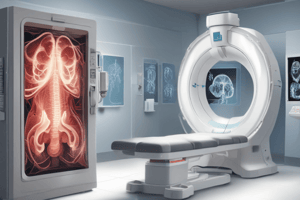Podcast
Questions and Answers
What is the primary role of diagnostic radiology?
What is the primary role of diagnostic radiology?
- To perform interventional procedures
- To administer radiation therapy to patients
- To diagnose and manage diseases using imaging technologies (correct)
- To treat diseases using radiation
Which imaging modality uses strong magnetic fields and radio waves to produce detailed images?
Which imaging modality uses strong magnetic fields and radio waves to produce detailed images?
- Computed Tomography (CT)
- X-ray
- Ultrasound
- Magnetic Resonance Imaging (MRI) (correct)
What is the primary role of radiologic technologists?
What is the primary role of radiologic technologists?
- To perform interventional procedures
- To administer radiation therapy to patients
- To operate imaging equipment and assist radiologists (correct)
- To interpret imaging studies
What is a critical safety consideration in radiology?
What is a critical safety consideration in radiology?
What is the primary role of therapeutic radiology?
What is the primary role of therapeutic radiology?
What is the primary application of mammography?
What is the primary application of mammography?
What is the primary role of radiologists?
What is the primary role of radiologists?
What is the primary role of radiation therapists?
What is the primary role of radiation therapists?
Flashcards are hidden until you start studying
Study Notes
Branches of Radiology
- Diagnostic Radiology: uses imaging technologies to diagnose and manage diseases
- Interventional Radiology: uses imaging-guided procedures to treat diseases
- Therapeutic Radiology: uses radiation to treat cancer and other diseases
Imaging Modalities
- X-ray: uses X-rays to produce images of internal structures
- Computed Tomography (CT): uses X-rays and computer algorithms to produce detailed cross-sectional images
- Magnetic Resonance Imaging (MRI): uses strong magnetic fields and radio waves to produce detailed images of internal structures
- Ultrasound: uses high-frequency sound waves to produce images of internal structures
- Positron Emission Tomography (PET): uses small amounts of radioactive materials to produce detailed images of metabolic activity
- Mammography: uses low-energy X-rays to produce detailed images of the breast tissue
Radiology Applications
- Cancer diagnosis and treatment: radiology plays a crucial role in diagnosing and treating cancer
- Trauma and emergency care: radiology helps diagnose and manage injuries and acute conditions
- Neuroimaging: radiology helps diagnose and manage neurological conditions such as stroke and brain tumors
- Cardiovascular imaging: radiology helps diagnose and manage cardiovascular conditions such as heart disease and vascular disorders
Radiology Professionals
- Radiologists: medical doctors who interpret imaging studies and perform interventional procedures
- Radiologic Technologists: healthcare professionals who operate imaging equipment and assist radiologists
- Radiation Therapists: healthcare professionals who administer radiation therapy to patients
Radiology Safety Considerations
- Radiation exposure: minimizing radiation exposure to patients and healthcare professionals
- Contrast agent safety: ensuring safe use of contrast agents used to enhance imaging studies
- Imaging equipment safety: ensuring proper maintenance and operation of imaging equipment
Branches of Radiology
- Diagnostic radiology diagnoses and manages diseases using imaging technologies
- Interventional radiology treats diseases using imaging-guided procedures
- Therapeutic radiology uses radiation to treat cancer and other diseases
Imaging Modalities
- X-ray produces images of internal structures using X-rays
- Computed Tomography (CT) uses X-rays and computer algorithms to produce detailed cross-sectional images
- Magnetic Resonance Imaging (MRI) produces detailed images of internal structures using strong magnetic fields and radio waves
- Ultrasound produces images of internal structures using high-frequency sound waves
- Positron Emission Tomography (PET) produces detailed images of metabolic activity using small amounts of radioactive materials
- Mammography produces detailed images of breast tissue using low-energy X-rays
Radiology Applications
- Radiology plays a crucial role in diagnosing and treating cancer
- Radiology helps diagnose and manage injuries and acute conditions in trauma and emergency care
- Radiology helps diagnose and manage neurological conditions such as stroke and brain tumors through neuroimaging
- Radiology helps diagnose and manage cardiovascular conditions such as heart disease and vascular disorders through cardiovascular imaging
Radiology Professionals
- Radiologists are medical doctors who interpret imaging studies and perform interventional procedures
- Radiologic technologists operate imaging equipment and assist radiologists
- Radiation therapists administer radiation therapy to patients
Radiology Safety Considerations
- Radiation exposure must be minimized for patients and healthcare professionals
- Contrast agents must be used safely to enhance imaging studies
- Imaging equipment must be properly maintained and operated to ensure safety
Studying That Suits You
Use AI to generate personalized quizzes and flashcards to suit your learning preferences.




